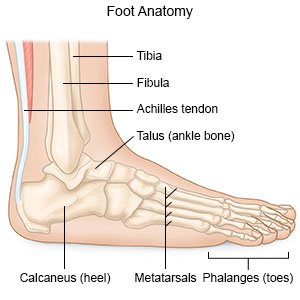Transmetatarsal Amputation
Medically reviewed by Drugs.com. Last updated on Aug 4, 2025.
WHAT YOU NEED TO KNOW:
Transmetatarsal amputation (TMA) is surgery to remove all or part of your forefoot. You may need TMA if you have a severe injury or infection, or poor blood flow to your foot.
 |
HOW TO PREPARE:
The week before your surgery:
- Arrange to have someone drive you home after surgery.
- Tell your surgeon about all the medicines you currently take. He or she will tell you if you need to stop any medicine before surgery, and when to stop. He or she will tell you which medicines to take or not take on the day of surgery.
- You may need blood tests, an EKG, or an x-ray before your surgery. Talk to your healthcare provider about these or other tests you may need. Write down the date, time, and location for each test.
The night before your surgery:
You may be told not to eat or drink anything after midnight.
The day of your surgery:
- You or a close family member will be asked to sign a legal document called a consent form. It gives healthcare providers permission to do the procedure or surgery. It also explains the problems that may happen, and your choices. Make sure all your questions are answered before you sign this form.
- Take only the medicines your surgeon told you to take.
- An IV will be put into a vein. You may get medicine or liquids through the IV.
- An anesthesiologist will talk to you before your surgery. You may need medicine to keep you asleep or numb an area of your body during surgery. Tell healthcare providers if you or anyone in your family has had a problem with anesthesia in the past.
WHAT WILL HAPPEN:
What will happen:
- Your surgeon will make incisions on your forefoot. Any damaged or infected bones will be cut and removed. Nerves, tendons, and blood vessels will be cut and closed off. Your surgeon will remove any infected or dead tissue and clean the inside of your foot. If the infection is severe, your incision wound will be packed with medical bandages and left open to heal.
- If your foot is not infected, the incision will be closed with stitches or staples. A skin graft from a donor or another part of your body may be used to cover your incision wound. One or more drains may be placed to remove extra blood and fluid from your wound. Bandages will be placed on your wound to help prevent bleeding and inflammation.
After your surgery:
You will be taken to a room to rest until you are fully awake. Healthcare providers will monitor you closely for any problems. Do not get out of bed until your healthcare provider says it is okay. When your healthcare provider sees that you are okay, you may be able to go home.
CONTACT YOUR HEALTHCARE PROVIDER IF:
- You cannot make it to your surgery.
- You have a fever.
- You get a cold or the flu.
- You have questions or concerns about your surgery.
Risks
You may bleed more than expected or get an infection. Your nerves or blood vessels may be damaged. You may have trouble walking after surgery. You may continue to feel the part of your foot that has been removed. You may get a blood clot in your limb. This may become life-threatening.
Related medications
Care Agreement
You have the right to help plan your care. Learn about your health condition and how it may be treated. Discuss treatment options with your healthcare providers to decide what care you want to receive. You always have the right to refuse treatment.© Copyright Merative 2025 Information is for End User's use only and may not be sold, redistributed or otherwise used for commercial purposes.
The above information is an educational aid only. It is not intended as medical advice for individual conditions or treatments. Talk to your doctor, nurse or pharmacist before following any medical regimen to see if it is safe and effective for you.
Further information
Always consult your healthcare provider to ensure the information displayed on this page applies to your personal circumstances.
